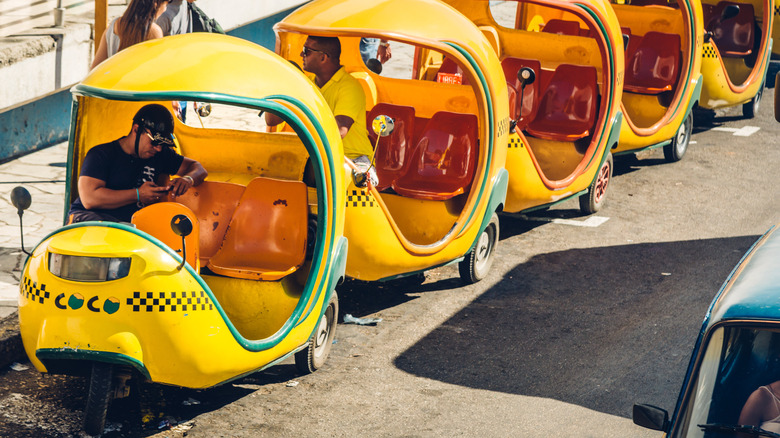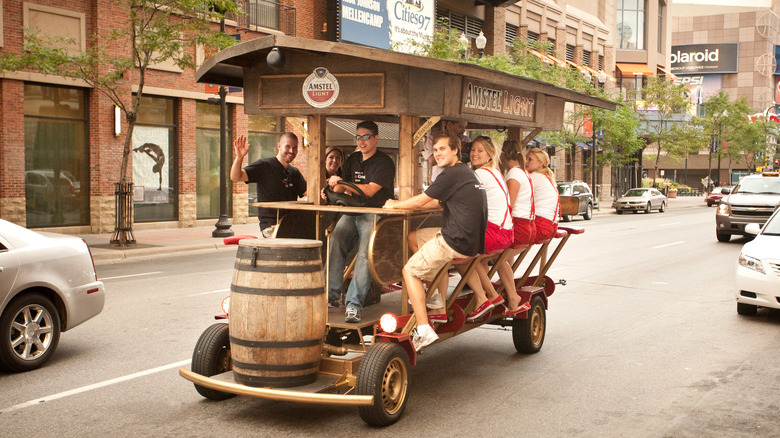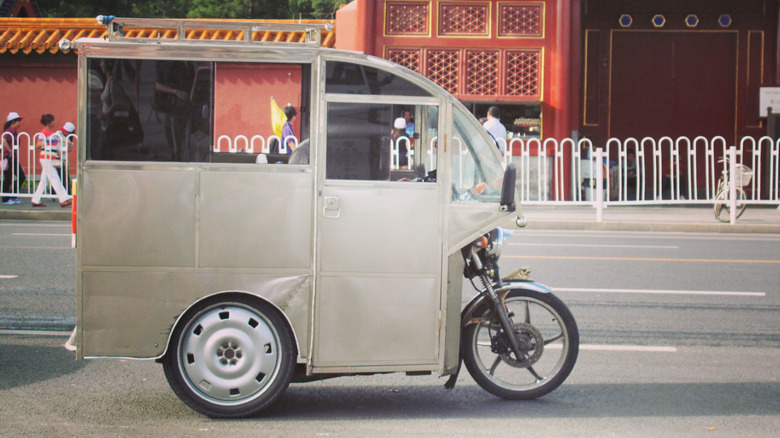10 Of The Most Unusual Modes Of Transportation You Can Use Today
Throughout history, there have been countless weird types of transport. From strange World War II vehicles to bizarre hearses, plenty of eye-catching and confusing designs have graced the earth, some so bad that they have long been forgotten in the vaults of history. Others have survived due to their practicality or popularity, and more are no doubt on the way as we hurtle ourselves into a technologically advanced future.
Fortunately, there are plenty of transport oddities around the world that you can ride today. Whether you're in the U.S. or traveling on a gap year around Asia, there are plenty of opportunities for unique vehicular experiences. Most are perfectly safe, but some will leave you to ride at your own risk. You may even be able to ride a few independently, but with many, you must put yourself in the care of a driver. With technology developing at the rate it is, some may not even have that.
From strange traditional vehicles facing their last hurrah to some that are placing a benchmark for the future, here are some of the most unusual modes of transportation you can use today.
The Amfibus in the Netherlands
Unsurprisingly, an Amfibus is an amphibious bus. Like its counterparts in the animal kingdom, it's as comfortable in the water as it is on land. Built by the Dutch Amfibious Transport company (DAT), this ingenious creation is one of the strangest ways to travel on water. The bus/boat can reach speeds of up to 8 knots (9.2mph/15kmph) down rivers and canals and 60 mph (96.5 kmph) on land.
At one point, it looked like the Amfibus was going to replace the ancient Renfrew Ferry in Glasgow, Scotland. However, technical complications arose, and the project was shelved. Still, the Amfibus soon found fame as the Floating Dutchman back in its native Netherlands. It transported tourists from Schiphol airport to the sights of Amsterdam and was popular with passengers on long layovers. Eventually, the airport discontinued the tour, again for technical reasons, and the future looked bleak for the Amfibus.
Not to be deterred, DAT got over the initial teething problems, and its primary creation became a popular tourist ride in the Dutch city of Rotterdam. The success of Splashtours eventually led to expansion into Amsterdam, Lübeck, and Porto. In addition, it has also led to DAT developing a Samsung-commissioned amphibious SUV called the Amphicruiser.
The Central to Mid-Levels Escalator in Hong Kong
If you want to ride on the world's longest outdoor escalator system and peer into restaurants, stores, and bars as you ascend above a dramatic cityscape, you need to go to Hong Kong. That's where you can find the Central to Mid-Levels Escalator. It's a multi-level safari of urban life and an ingenious way for locals and tourists to navigate the city's challenging heights without breaking a sweat. It stretches for over 800 meters and climbs 135 meters up into the steep urban hills.
The system ferries sleepy-eyed commuters downhill from 6 am until 10 am before changing direction and going uphill until midnight. It was initially built to reduce traffic congestion in the Mid-Levels district of the city and consists of 20 escalators and three inclined moving walkways. However, the escalator did very little to reduce said congestion. At a substantial cost of $30 million, it was criticized as a costly mistake. Despite this, the areas of Soho and Lan Kwai Fong became more accessible and soon developed into busy nightlife areas for locals and tourists alike seeking drinks and dining.
Along with the Peak Tram, old-fashioned public trams, and the city's red double-decker buses, the Central to Mid-Levels Escalator is another of Hong Kong's iconic modes of transport. Still, city developers weren't content with just one outrageously long outdoor escalator. Ocean Park, a premier marine park and aquarium, went on to build the world's second-longest. There literally isn't any other place other than Hong Kong where you can say you rode the two longest outdoor escalators on the planet.
The Optics Valley Photon Skyrail in Wuhan
Many weird and wonderful transportation types have been proposed or developed in China over the years. Some would be marketed and tested but, ultimately, never see the light of day. One these is the elevated bus that was supposed to ease traffic congestion by passing over the top of cars. However, one that has made it into daily operation is the Optics Valley Photon Skyrail in the city of Wuhan.
Wuhan may have been dominating headlines not so long ago for unfortunate reasons, but the city is now gaining recognition for its innovative suspended monorail. It features a unique glass floor that gives passengers downward views as well as side views out of the regular windows. Not only can passengers enjoy the 270-degree views, but they can also enjoy (or not enjoy) the fact that it's a driverless train.
It's a battery-powered, two-car train built by CRRC Qingdao Sifang, one of the world's largest manufacturers of railway equipment. It has a capacity for 220 passengers and, as it is primarily designed for sightseeing, approximately the same amount of selfie sticks.
The 6.6-mile (10.5km) line runs from Jiufeng National Forest Park to Longquanshan, and the autonomous train can hit speeds of up to 37 mph (60 kmph). It might be considered a gimmick, but China does have a history with hair-raising glass floors. So, if by chance you ever visit the city of Wuhan, there's a definite weird transport bucket list entry to check off there.
The bamboo train in Cambodia.
Picture yourself hurtling down an unmaintained track on a flat square of bamboo on top of a wooden frame. This is what it's like to ride the Norry in Cambodia, a bed-sized platform that features a small but noisy engine, a driver, room for up to 15 passengers, and sits on two axles with wheels welded in place.
While it is an exciting, bone-jarring ride, the speed is limited to 25mph, making collisions with other oncoming bamboo trains are easily avoidable. However, it's a single-track line — what does happen when another Norry comes the other way? Well, one of the drivers simply stops, unloads the passengers, semi-disassembles the vehicle, waits for the oncoming Norry to pass, reassembles, and then carries on down the track on their merry way.
These improvised forms of transport began to show up after years of neglect to the rail network during the genocidal reign of Pol Pot. Before long, a thriving Norry system was established to transport produce, animals, and people.
However, the Cambodian government has been successfully working to restore the country's rail network in recent years. As a result, most Norry routes have disappeared. However, a couple remain for tourist purposes, including one outside the charming city of Battambang. So, if you're ever in the area, be sure to visit and ride one of the world's most unusual forms of transport, if you have the nerve for it.
The Coco taxi in Cuba
When traveling to Cuba, one of the delights of the country is witnessing all the classic American cars that still dominate the roads there. Thanks to the 60-year U.S. trade embargo, the streets of Havana and other cities are something of a vintage automobile museum. From vintage Chevrolets to classic Fords, the cars that were imported to Cuba in the '50s are still the cars being driven around today.
So, the sight of the coco taxi among all that splendor can be somewhat unusual and perhaps even disappointing. It's named after its odd-looking coconut-shaped shell, and these bright yellow three-wheeled autorickshaw taxis are mainly found around the capital city of Havana. They feature noisy two-stroke engines with a maximum speed of around 30mph (48kmph) and are primarily for tourists — locals ride the black or blue coco taxis.
While the two-stroke engine is becoming a thing of the past, the coco taxi seems to be here to stay, at least for a while. Along with the engine being a bit of an earsore, the yellow, fiberglass coconut shell is a bit of an eyesore. However, the taxis don't belong to any one company, so drivers are independent and fares are cheaper than regular taxis.
Yet, they are prone to breakdowns, and some government websites deem them unsafe and advise against traveling on them. However, if you decide to take the risk, it's a fun ride that will get you from A to B at a very low cost. Just make sure you learn the Spanish for "slow down."
The beer bike in Amsterdam
The beer bike — also known as the party bike — was first seen in the city of Amsterdam. Basically, it's a 17-foot-long mobile bar that is pedaled through the streets by customers sitting on stools. These stools are placed around the bar, which comes complete with a bartender, and you can find the pedals at the bottom. Crucially, the beer bike also has a driver who controls the direction of the traveling bar, thus avoiding nasty accidents involving drunken patrons.
However, accidents have happened, and Amsterdam residents have also complained about boorish behavior. Drunks have been seen shouting and urinating in public, and the beer bikes were eventually banned from the center of the city. Time magazine even shared one story of a bunch of lads stopping in front of some "service providers" in the city's famous red-light district. The women took the opportunity to showcase their talents to try and entice some business, which encouraged much cheering, shouting, and general lewd behavior from the beer bike. Reportedly, it was quite a performance, but residents were understandably upset, considering it was only noon.
However, the negative image of the beer bike hasn't stopped other countries from picking up on the trend. You can now hire them in cities across Europe and even across the pond in Canada and the USA. They are also known by a variety of different names, such as the Pedal Pub Twin Cities tours in Minneapolis. Like Amsterdam, opinions on the beer bike are split among residents there. However, according to online reviews, patrons are delighted with the service.
The motorized sanlunche taxi in China
Sanlunche (pronounced san-loon-chuh) literally translates as three-wheeled vehicle, and that's precisely what it is. The sanlunche can be pedal-powered or motorized and across China the motorized version is often converted into a rudimentary form of autorickshaw taxi. It consists of silver box housing with transparent plastic windows that can seat one passenger (or two small ones).
It also feels like it could fall apart at any given moment. The design is makeshift at best, and it often looks as if it was put together in someone's basement rather than at a reputable factory. The sanlunche is powered by a moped with a small, underpowered engine, and the overall design of the vehicle looks quite ridiculous in China's modern cities.
Also known as a beng beng (jump jump) by some residents due to the guaranteed bumpy ride, the sanlunche can be a faster option in the rush hour with its ability to wind through traffic. In order to get passengers to where they're going on time, they even take to the sidewalk on occasion, which pedestrians don't seem to mind too much.
The drivers are usually unlicensed, and there are ongoing government crackdowns to rid the country of these polluting vehicles. In China's major cities, such as Beijing and Shanghai, they can be difficult to find nowadays. However, they are still around, and if you manage to see one, negotiate a fare and take a ride. You might feel a bit silly, but hold on tight and let the sanlunche get you wherever you're going quickly and cheaply.
The Monte toboggan in Madeira
Since the end of the 19th century, the toboggan has been a unique yet exhilarating way to descend from the parish of Monte to the sea-level town of Funchal on the island of Madeira, Portugal. Monte sits at an elevation of 1,529 feet (466 meters), and the descent is steep. You could take the bus all the way down to Funchal, but why would you when you can take an unforgettable and exhilarating ride you will never forget?
Locally known as the Carros de Cesto do Monte, these toboggans were once used by locals as a form of public transport. Nowadays, it is primarily tourists who enjoy the breakneck ride with dramatic views of Funchal set against a stunning Atlantic Ocean backdrop. These antiquated toboggans are made from wood and wicker and seat two people who are guided by two carreiros. These drivers are usually kitted out in white and sport distinctive straw hats. They also wear thick rubber-soled boots that they use to brake, steer, and slow down the toboggans.
It isn't unusual to reach speeds of up to 30 mph (48 kmph), and the thrilling 2 km winding descent is over in around 10 minutes. Unfortunately, the toboggans no longer go all the way to Funchal, and you'll have to walk the remaining couple of kilometers of the steep hill or find public transport.
The Ice Angel in Wisconsin
During the warm summer months, the 250 or so citizens of Madeline Island in Wisconsin can easily reach the mainland by ferry. Once the bleak winter rolls in, however, a two-mile ice highway is formed on Lake Superior that is safe for vehicles to cross. However, for a six-week period in between, the water is not manageable for ferries, and the ice too thin for vehicles. During that time, citizens rely on the unique Ice Angel to transport themselves the three miles or so to the micro-sized 'city' of Bayfield.
The Ice Angel is a windsled that uses large propellers to launch itself and has a flat bottom to skate over the thin ice. It not only transports passengers to the mainland, but it also gets kids to school on time and is sometimes even used as a unique rescue vehicle.
Unfortunately, the origins of the Ice Angel lie in tragedy. When a 16-year-old boy fell through the ice and drowned, Wisconsin Congressman David Obey pushed for funds to develop the windsled as a rescue vehicle. Initially, the idea was roundly criticized by the Senate and deemed a waste of funds. However, the idea soon gained traction after interest from law enforcement groups around the Great Lakes.
Two decades later, the Ice Angel is still rescuing people on the ice, including two separate groups of five anglers who became stranded on ice floes in December 2016. If you want to ride these life-saving creations, you'll have to visit Madeline Island at the right time of year.
The cyclo in Vietnam
Hoan Kiem is an ancient lake situated slap bang in the middle of the Old Quarter in Vietnam's capital city, Hanoi. This small lake is encircled all day by thousands of honking cars and the ubiquitous scooters that the country is renowned for. However, a more daring way to get around the antiquated sites of this lake is by cyclo.
Cyclos have been an icon of Vietnam since the early 1940s. They are pedal-powered tricycles that seat one or two passengers in a comfortably padded chair with the hard-working driver positioned behind. Ubiquitous in the country until the motorbike became an affordable means of transportation at the turn of the century, the cyclo has now dwindled in numbers. When it started to hinder traffic flow, cities began to ban their use. As their numbers diminished, cyclo drivers turned to tourists to make their living. Today, very few remain, but you can still find them around some of the country's main tourist sites, including the Old Quarter.
They don't cost much, and if you ride when the roads are quieter, it can be a (somewhat) relaxing tour. If you seek a bit of a thrill, hold on during the rush hour and shriek with exhilaration as your driver navigates chaotic streets and narrow alleyways for your twisted pleasure.


